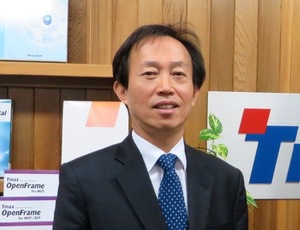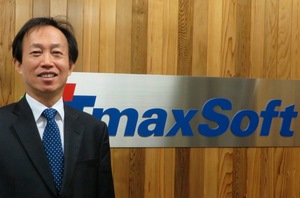
| Press | “From Oracle Compatibility to Surpassing Oracle, Focus on Data Management is Key” Chairman and CTO of TmaxSoft | 2015-05-22 |
|---|
Source: IT
Leaders, Japan (http://it.impressbm.co.jp/articles/-/12296,
http://it.impressbm.co.jp/articles/-/12296?page=2)
“From Oracle Compatibility to Surpassing Oracle, Focus
on Data Management is Key”
Chairman and CTO of TmaxSoft
April 22nd, 2015 (Wed) Shido Masahiro (Chief
Editor, IT Leaders)
Tibero, TmaxSoft’s RDBMS
previously emphasized its compatibility with Oracle. Tibero is now garnering
attention in the Korean market for its status as Oracle's main rival. Through
its product lineup, which includes a web application server and TP (Transaction
Processing) monitor, TmaxSoft holds over 50% share of the Korean middleware
market. TmaxSoft is now focusing on aggressive global expansion with by
targeting companies that employ databases. So, what makes TmaxSoft so confident
in Tibero? We interviewed TmaxSoft’s founder and CTO (Chief Technology Officer)
Chairman Daeyeon Park to find the answer.

Chairman Daeyeon Park, Founder and CTO of TmaxSoft
── I've
heard that TmaxSoft has been expanding its market share through its
compatibility with Oracle.
TmaxSoft and
Oracle are competitors. As an alternative to Oracle, our focus isn't to develop
an Oracle compatible database. We hold over 50% share of the Korean middleware
market, and the DBMS (database management system) is the most complex and
difficult middleware product to implement. This is because a DBMS handles data,
the lifeline of any company that uses a database.
Creating a DBMS
that is absolutely integral to an enterprise environment has always been our
goal and dream. TmaxSoft has been working on this
dream since 2001. Even before that time, before TmaxSoft, I have been designing
DBMS through trial and error when I was working in a bank's IT department about
30 years ago.
Going back to the
topic of Oracle compatibility, to ensure 100% compatibility with Oracle, the
entire system must be built similarly to Oracle. Otherwise, the DBMS cannot ensure
reliability or performance.
In the DBMS world,
SQL is the international standard for data manipulation languages. By being fully
SQL compliant and offering clients a standardized product, users are able to
freely choose a DBMS without worrying about compatibility. Web application
servers (WAS) are an example of being fully standardized internationally and allowing
users to benefit from price and technological competition.
While
developing Tibero, our goal was to be fully compliant with the “SQL99” standard
set in 1999. However, Oracle adds independent
functions to differentiate itself from competitors. Even though Tibero is fully
compliant with SQL99, we added functions compatible to Oracle’s independent
functions. To say once again, compatibility with
Oracle is not the focus of our technology. Our goal is to pursue development of
a core engine for data management and to provide users with choice.
Interestingly, DBMS
vendors such as Microsoft and IBM are not working towards being fully compliant
with SQL; it seems like they have given up on being fully compliant. Since
developing a DBMS is complex in itself, it requires knowledge of basic software
and other middleware. Each area of development is highly specialized, and it's
very easy for each area to become isolated. The right talent and proper
oversight is needed to oversee all areas and direct them toward a common goal.
For development
engineers, it is easier for them to acquire the necessary skills if the API (Application
Programming Interface) is standardized. Recently, various
configurations of DBMS are being automated, which is continually changing the
type of skills demanded of engineers. Even if an engineer learns the
configuration skills for each vendor’s DBMS, it does not bring much value.
──Recently, PostgreSQL
has also emphasized compatibility with Oracle, but its penetration rate seems
to be low.
This is because
adopting an unstable or low compatibility DBMS incurs high costs and faces
system problems.
For example, when a
client migrates to another DBMS due to dissatisfaction with Oracle, if the new
and old DBMS are not perfect compatibility, both DBMS must be used. This
situation eliminates any potential cost reductions and increases the chances of
integration issues occurring. In the end, the client goes back to Oracle. This
cycle, repeated by many clients, resulted in Oracle’s monopolistic presence.
As mentioned
earlier, it is easy to develop a DBMS to be 90% similar, but the last 10% is
related to the core engine, which is much more complex. The reason why
Microsoft and IBM gave up was because of the endless cycle mentioned earlier.
── I heard that
there are many Tibero migration cases in Korea.
Currently, the number
of Oracle to Tibero migrations and the number of initial adoptions of Tibero
are about equal. When we first introduced Tibero to the market, we played the
role of being an alternative to Oracle. With this in mind, clients began
dropping our name when negotiating with Oracle to gain a pricing leverage.
Clients were of the mind that if a problem arose with Tibero, then they could
just simply go back to Oracle.
However, after
actually adopting Tibero, client attitudes changed. More and more clients are now
selecting Tibero, not as an alternative, but as the preferred choice. For
example, Hyundai Motors is a major client of Oracle. But recently, Hyundai chose
Tibero as their official DBMS product as well as other middleware. We plan on
reforming the entire middleware landscape on the global scale. There are even cases
of clients using Oracle as a backup to Tibero, which helped the client receive
significant discounts.
However, once the
age of cloud fully arrives, comparison/competition based on on-premises
software will become meaningless. Cloud service users may be interested in cost,
but they aren't interested in the technology used in cloud. They don't care
which vendor’s DBMS is used.
When cloud
providers actually verify Tibero’s operation, they quickly realize that it is to
their advantage to migrate to Tibero. Recently, Japan’s Uniadex tested Tibero 5
with Oracle, and Tibero performed slightly below Oracle. However, this
performance difference was more than made up by the cost savings. The savings
allowed Uniadex make up for the performance loss through increased DBMS
hardware expenditures. In addition, the next version of Tibero is expected to
offer superior performance results.
We have been holding
discussions with a large global cloud service provider to increase their price
competitiveness by migrating their DBMS to Tibero.
── You said that you are going to focus on development of the core
engine. Are you going to increase compatibility with Oracle?
As I have mentioned
before, our final objective is not compatibility with Oracle. We adopted Oracle
functions in Tibero 5 (the current version), but the core engine has reached its
limits in adding functions. As a result, Tibero
6 will adopt a new architecture to offer functions that Oracle does not have
and surpass Oracle. We have already completed 99% of testing, and it is
expected to be ready for release around July 2015.

Chairman Daeyeon Park, Founder and CTO of TmaxSoft
The number of functions
that a DBMS must offer will only continue to increase. In the age of cloud and
IoT (Internet of Things), a DBMS has to offer an environment for easy application
development.
The biggest change
to DBMS architecture is the multi-thread structure called 'Hyper Thread
Architecture'. While the single-thread architecture consumes a large amount of
resources, a multi-thread architecture can offer higher performance with
greater resource efficiency. The effectiveness of the multi-thread
architectures has already been verified in WAS.
With our goals
to improve security and to shorten recovery time in mind, we chose parallel
processing.
Tibero 6 is also an
engine that supports big data. We have a product called ZetaData, which is an
appliance server that combines Tibero with storage server technology and a high-speed
network. It can process OLTP (OnLine Transaction Processing) and OLAP (OnLine Analytical
Processing) simultaneously. Already, we have had discussions concerning creating
an appliance with many American server vendors.
In addition to the
functions already mentioned, Tibero’s compatibility with other DBMS will also
be enhanced. While our compatibility with Oracle is already known, we also want
to improve our compatibility with SQLServer and DB2 to begin migrating those
DBMS to Tibero. In Tibero 7, we plan on offering this compatibility.
In Tibero 7, we
will implement in-memory technology and sensor data technology, which will be
needed in the age of IoT. While many in-memory DBMS products are read-only, Tibero
will be both read and write. Although most of the functions have already been
developed, they will be implemented in Tibero 7 because the new architecture is
focal point in Tibero 6. Tibero 7 is set to for release in the second half of
2015.
In the future,
we plan on differentiating ourselves from Oracle by developing these technologies.
I would just like to say, we're not trying to criticize competing products. In
the future data-centric age, there will be a greater need for an environment that
integrates and analyzes all data. The current technology, however, does not
have the ability integrate all databases.
To use various DBMS
types, each with different applications and security concepts, data
virtualization technology will become important in the future.
──What is the future
business plan for the Japanese market?
Japan is an
important foothold for our overseas expansion plans. As TmaxSoft's first
overseas subsidiary, TmaxSoft Japan is expanding the number of sales partners for
direct customer support.
In the future, we
plan on establishing an R&D center for Japanese-specific research and
development. This center will be able to provide functions and code to meet the
specific needs of Japanese clients. Establishing an overseas R&D center is in
response to strong customer demand and to concerns about Korea's political
stability. Placing source code in many regions will help allay customers
concerns. Thanks to the high quality and standards of Japanese companies, research
and development in Japan will lead to increased global competitiveness for
TmaxSoft.